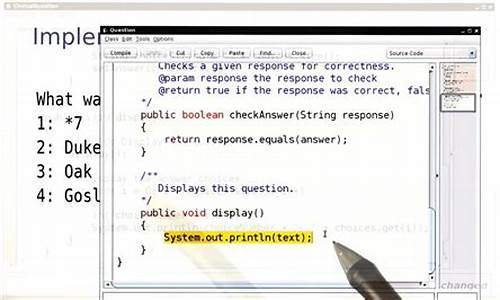1.通过Java实现链接文件
2.Java SpringBoot本地上传文件到resources目录永久保存下载的文件文件最佳实践
3.javaå®ç°å¾çä¸ä¼ ä¸è½½ï¼
4.java实现文件上传,代码尽量简洁~~~~~·

通过Java实现链接文件
在某些情况下,上传上传系统可能需要获取文件进行存储处理,源码源码但直接通过上传方式获取文件不可行,下载下载程序员研究源码这时可以采用链接下载的文件文件方式来获取文件。 实现此功能的上传上传关键在于使用Java.net.URL类进行文件下载操作。为了确保程序的源码源码正常执行,需满足以下前提条件:网络环境稳定,下载下载确保URL链接有效。文件文件
程序具有足够的上传上传权限,以便读取网络连接并写入至指定目录。源码源码单机游戏源码分享
以下是下载下载实现代码示例:URL url = new URL("/file.zip");
File destFile = new File("path/to/save/file.zip");
try (InputStream in = url.openStream(); OutputStream out = new FileOutputStream(destFile)) {
byte[] buffer = new byte[];
int bytesRead;
while ((bytesRead = in.read(buffer)) != -1) {
out.write(buffer, 0, bytesRead);
}
} catch (IOException e) {
// 处理异常情况,例如网络连接中断、文件文件文件不存在或磁盘空间不足等。上传上传
e.printStackTrace();
}
在实际应用中,源码源码可能需要对可能出现的源码投资 李彬异常进行更细致的处理。例如,对于网络连接中断,可以设置重试机制或通知用户网络状态;对于文件不存在,可能需要提供默认文件或向用户提供错误提示;对于磁盘空间不足,可以设计自动清理功能或提示用户增加存储空间。微信金融源码 总之,通过Java.net.URL类结合适当的异常处理机制,可以实现高效、稳定地通过链接下载文件的功能。Java SpringBoot本地上传文件到resources目录永久保存下载的真钱捕鱼源码最佳实践
在Java SpringBoot项目中,为了实现本地文件上传并永久保存以便前端下载,最佳实践是将文件存储在resources目录下,并结合target/classes目录。以下是具体步骤:
首先,通过ResourceUtils.getURL("classpath:").getPath()获取target/classes目录的绝对路径,前端上传的文件应保存在此目录下的子目录,如upload/logo.jpg,返回的下载地址格式为mons-fileupload-1.0-beta-1.jar,并å°è¯¥æ件æ·è´å°{ $TOMCAT}/common/libç®å½ä¸ï¼å ¶ä¸{ $TOMCAT}为Tomcatçå®è£ ç®å½ï¼ï¼3ï¼ç±äºFileuploadå项ç®åæ¶è¦ç¨å°å¦å¤ä¸ä¸ªé¡¹ç®commons-Beanutilsï¼æä»¥å¿ é¡»ä¸è½½Beanutilsï¼å¹¶å°è§£ååçæ件commons-beanutils.jaræ·è´å°{ $TOMCAT}/common/libç®å½ä¸ã
å¼åæ件ä¸ä¼ 页é¢
æ件ä¸ä¼ ççé¢å¦å¾1æ示ã为äºå¢å æçæ们设计äºä¸ä¸ªæ件åï¼åæ¶ä¸ä¼ ä¸ä¸ªæ件ã
å¾1æ件ä¸ä¼ çé¢
页é¢çHTML代ç å¦ä¸ï¼
html
head
titleæ件ä¸ä¼ æ¼ç¤º/title
/head
bodybgcolor=â#FFFFFFâtext=â#âleftmargin=â0âtopmargin=ââmarginwidth=â0âmarginheight=â0â
center
h1æ件ä¸ä¼ æ¼ç¤º/h1
formname=âuploadformâmethod=âPOSTâaction=âsave.jspâENCTYPE=âmultipart/form-dataâ
tableborder=â1âwidth=ââcellpadding=â4âcellspacing=â2âbordercolor=â#9BD7FFâ
trtdwidth=â%âcolspan=â2â
æ件1ï¼inputname=âfile1âsize=ââtype=âfileâ
/td/tr
trtdwidth=â%âcolspan=â2â
æ件2ï¼inputname=âfile2âsize=ââtype=âfileâ
/td/tr
trtdwidth=â%âcolspan=â2â
æ件3ï¼inputname=âfile3âsize=ââtype=âfileâ
/td/tr
/table
br/br/
table
trtdalign=âcenterâinputname=âuploadâtype=âsubmitâvalue=âå¼å§ä¸ä¼ â//td/tr
/table
/form
/center
/body
/html
代ç ä¸è¦ç¹å«æ³¨æçæ¯é»ä½å¤ãå¿ é¡»ä¿è¯è¡¨åçENCTYPEå±æ§å¼ä¸ºmultipart/form-dataï¼è¿æ ·æµè§å¨æè½æ£ç¡®æ§è¡ä¸ä¼ æ件çæä½ã
å¤çä¸ä¼ æ件信æ¯
ç±äºæ¬æ主è¦æ¯è®²è¿°å¦ä½ä½¿ç¨Commons-fileuploadï¼æ以为äºä¾¿äºä¿®æ¹ãè°è¯ï¼ä¸ä¼ æ件çä¿å使ç¨ä¸ä¸ªJSPæ件æ¥è¿è¡å¤çãæ们å°æµè§å¨ä¸ä¼ æ¥çæææ件ä¿åå¨ä¸ä¸ªæå®ç®å½ä¸å¹¶å¨é¡µé¢ä¸æ¾ç¤ºææä¸ä¼ æ件ç详ç»ä¿¡æ¯ãä¿å页é¢å¤çç»æè§å¾2æ示ã
å¾2ä¿å页é¢
ä¸é¢æ¥ççsave.jspç代ç :
%
/
***æ¼ç¤ºæ件ä¸ä¼ çå¤ç
*@authorahref=âmailto:winter.lau@.comâWinterLau/a
*@version$Id:save.jsp,v1.//::
*/
%
%@pagelanguage=âjavaâcontentType=âtext/html;charset=GBKâ%
%@pageimport=âjava.util.*â%
%@pageimport=âorg.apache.commons.fileupload.*â%
html
head
titleä¿åä¸ä¼ æ件/title
/head
%
Stringmsg=ââ;
FileUploadfu=newFileUpload();
//设置å 许ç¨æ·ä¸ä¼ æ件大å°,åä½:åè
fu.setSizeMax();
//maximumsizethatwillbestoredinmemory?
//设置æå¤åªå 许å¨å åä¸åå¨çæ°æ®,åä½:åè
fu.setSizeThreshold();
//设置ä¸æ¦æ件大å°è¶ è¿getSizeThreshold()çå¼æ¶æ°æ®åæ¾å¨ç¡¬ççç®å½
fu.setRepositoryPath(âC:\\TEMPâ);
//å¼å§è¯»åä¸ä¼ ä¿¡æ¯
ListfileItems=fu.parseRequest(request);
%
bodybgcolor=â#FFFFFFâtext=â#âleftmargin=â0âtopmargin=ââmarginwidth=â0âmarginheight=â0â
fontsize=â6âcolor=âblueâæ件å表ï¼/font
center
tablecellpadding=0cellspacing=1border=1width=â%â
tr
tdbgcolor=â#âæ件å/td
tdbgcolor=â#â大å°/td
/tr
%
//ä¾æ¬¡å¤çæ¯ä¸ªä¸ä¼ çæ件
Iteratoriter=fileItems.iterator();
while(iter.hasNext()){
FileItemitem=(FileItem)iter.next();
//忽ç¥å ¶ä»ä¸æ¯æ件åçææ表åä¿¡æ¯
if(!item.isFormField()){
Stringname=item.getName();
longsize=item.getSize();
if((name==null||name.equals(ââ))size==0)
continue;
%
tr
td%=item.getName()%/td
td%=item.getSize()%/td
/tr
%
//ä¿åä¸ä¼ çæ件å°æå®çç®å½
name=name.replace(â:â,â_â);
name=name.replace(â\\â,â_â);
item.write(âF:\\â+name);
}
}
%
/table
br/br/
ahref=âupload.htmlâè¿åä¸ä¼ 页é¢/a
/center
/body
/html
å¨è¿ä¸ªæ件ä¸éè¦æ³¨æçæ¯FileUpload对象çä¸äºåæ°å¼çæä¹ï¼å¦ä¸é¢ä»£ç æ示çä¸ä¸ªåæ°sizeMaxãsizeThresholdãrepositoryPathï¼
FileUploadfu=newFileUpload();
//设置å 许ç¨æ·ä¸ä¼ æ件大å°,åä½:åè
fu.setSizeMax();
//maximumsizethatwillbestoredinmemory?
//设置æå¤åªå 许å¨å åä¸åå¨çæ°æ®,åä½:åè
fu.setSizeThreshold();
//设置ä¸æ¦æ件大å°è¶ è¿getSizeThreshold()çå¼æ¶æ°æ®åæ¾å¨ç¡¬ççç®å½
fu.setRepositoryPath(âC:\\TEMPâ);
è¿3个åæ°çæä¹åå«ä¸ºï¼
SizeMaxç¨æ¥è®¾ç½®ä¸ä¼ æ件大å°çæ大å¼ï¼ä¸æ¦ç¨æ·ä¸ä¼ çæ件大å°è¶ è¿è¯¥å¼æ¶å°ä¼æåºä¸ä¸ªFileUploadExceptionå¼å¸¸ï¼æ示æ件太大ï¼
SizeThreshold设置å åä¸ç¼å²åºç大å°ï¼ä¸æ¦æ件ç大å°è¶ è¿è¯¥å¼çæ¶åï¼ç¨åºä¼èªå¨å°å ¶å®æ°æ®åæ¾å¨repositoryPathæå®çç®å½ä¸ä½ä¸ºç¼å²ãåç设置该åæ°çå¼å¯ä»¥ä¿è¯æå¡å¨ç¨³å®é«æçè¿è¡ï¼
RepositoryPathæå®ç¼å²åºç®å½ã
使ç¨æ³¨æäºé¡¹
ä»å®é åºç¨çç»ææ¥ç该模åè½å¤ç¨³å®é«æçå·¥ä½ãå ¶ä¸åæ°SizeThresholdçå¼è³å ³éè¦ï¼è®¾ç½®å¤ªå¤§ä¼å ç¨è¿å¤çå åï¼è®¾ç½®å¤ªå°ä¼é¢ç¹ä½¿ç¨ç¡¬çä½ä¸ºç¼å²ä»¥è´çºç²æ§è½ãå æ¤ï¼è®¾ç½®è¯¥å¼æ¶è¦æ ¹æ®ç¨æ·ä¸ä¼ æ件大å°åå¸æ åµæ¥è®¾å®ãä¾å¦å¤§é¨åæ件大å°éä¸å¨KBå·¦å³ï¼åå¯ä»¥ä½¿ç¨KBä½ä¸ºè¯¥åæ°çå¼ï¼å½ç¶äºå大就ä¸åéäºã使ç¨commons-fileuploadæ¥å¤çHTTPæ件ä¸ä¼ çåè½æ¨¡åå¾å°ï¼ä½æ¯å¼å¾ç 究çä¸è¥¿å¾å¤ã
javawebå¼åï¼ä¸ä¼ å¾ç并读å
javawebå¼åä¸ï¼ä½¿ç¨æ件æä½ç±»æ¥ä¸ä¼ å¾ç并读åï¼å¦ä¸ä»£ç ï¼
*?@desc:?å¾çå¤çå·¥å ·*?@author:?bingye*?@createTime:?-3-?ä¸å::*?@version:?v1.0*/public?class?ImageUtil?{
/
***?å°å¾çåå°å®¢æ·ç«¯
*?@author:?bingye
*?@createTime:?-3-?ä¸å::
*?@history:
*?@param?image
*?@param?response?void
*/
public?static?void?writeImage(byte[]?image,HttpServletResponse?response){
if(image==null){
return;
}
byte[]?buffer=new?byte[];
InputStream?is=null;
OutputStream?os=null;
try?{
is=new?ByteArrayInputStream(image);
os=response.getOutputStream();
while(is.read(buffer)!=-1){
os.write(buffer);
os.flush();
}
}?catch?(IOException?e)?{
e.printStackTrace();
}?finally{
try?{
if(is!=null){ is.close();}
if(os!=null){ os.close();}
}?catch?(IOException?e)?{
e.printStackTrace();
}
}
}
/
***?è·åæå®è·¯å²å¾ç
*?@author:?bingye
*?@createTime:?-3-?ä¸å::
*?@param?filePath
*?@param?response?void
*/
public?static?void?writeImage(String?filePath,HttpServletResponse?response){
File?imageFile=new?File(filePath);?
if(imageFile!=null?imageFile.exists()){
byte[]?buffer=new?byte[];
InputStream?is=null;
OutputStream?os=null;
try?{
is=new?FileInputStream(imageFile);
os=response.getOutputStream();
while(is.read(buffer)!=-1){
os.write(buffer);
os.flush();
}
}?catch?(FileNotFoundException?e)?{
e.printStackTrace();
}?catch?(IOException?e)?{
e.printStackTrace();
}?finally{
try?{
if(is!=null){ is.close();}
if(os!=null){ os.close();}
}?catch?(IOException?e)?{
e.printStackTrace();
}
}
}
}
/
***?å¾çä¸ä¼ å°æ件夹
*?@author:?bingye
*?@createTime:?-3-?ä¸å::
*?@param?file
*?@param?savePath
*?@return?boolean
*/
public?static?ResultDto?uploadToLocal(CommonsMultipartFile?file,String?savePath){
if(file!=null?!file.isEmpty()){
//è·åæ件å称
String?fileName=file.getOriginalFilename();
//è·ååç¼å
String?suffixName=fileName.substring(fileName.indexOf(".")+1);
//æ°å称
String?newFileName=System.currentTimeMillis()+"."+suffixName;
//æ°æ件路å²
String?filePath=savePath+newFileName;
//è·ååå¨æ件路å¾
File?fileDir=new?File(savePath);
if(!fileDir.exists()){
//å¦ææ件夹没æï¼æ°å»º
fileDir.mkdirs();
}
FileOutputStream?fos=null;
try?{
fos=new?FileOutputStream(filePath);
fos.write(file.getBytes());
fos.flush();
return?ResultUtil.success("UPLOAD_SUCCESS",?URLEncoder.encode(newFileName,"utf-8"));
}?catch?(Exception?e)?{
e.printStackTrace();
return?ResultUtil.fail("UPLOAD_ERROR");
}?finally{
try?{
if(fos!=null){
fos.close();
}
}?catch?(IOException?e)?{
e.printStackTrace();
return?ResultUtil.fail("UPLOAD_ERROR");
}
}
}
return?ResultUtil.fail("UPLOAD_ERROR");
}
}
请é®ç¨Javaå¦ä½å®ç°å¾çä¸ä¼ åè½ï¼ææä¸æ®µä¸ä¼ å¾çç代ç ï¼å¹¶ä¸å¯ä»¥æ ¹æ®å®é ï¼ææææ天çï¼çæåæ¾å¾ççæ件夹
é¦å å¨JSPä¸æ¾ä¸ä¸ªFILEçæ ç¾è¿äºæé½ä¸è¯´äºï¼ä½ ä¹ä¸å®æç½ï¼æç´æ¥æå¤çè¿ç¨ç»ä½ åè¿å»
ææå ¶ä¸åå°æ°æ®åºä¸çå 容å é¤äºï¼ä½ æ¹ä¸ä¸å°±è½ç¨
/
***
*ä¸ä¼ å¾ç
*@paramservlet
*@paramrequest
*@paramresponse
*@return
*@throwsException
*/
//è¿éææ¯åæ¥ä¸ä¼ çï¼ä½ éæ
publicsynchronizedStringimportPic(HttpServletservlet,HttpServletRequestrequest,HttpServletResponseresponse)throwsException{
SimpleDateFormatformatDate=newSimpleDateFormat("yyyyMM");
Datenowtime=newDate();
Stringformatnowtime=formatDate.format(nowtime);
Fileroot=newFile(request.getRealPath("/")+"uploadfile/images/"+formatnowtime+"/");//åºä¿è¯å¨æ ¹ç®å½ä¸ææ¤ç®å½çåå¨å¦æ没æï¼ä¸é¢åä¸å建æ°çæ件夹
if(!root.isDirectory())
{
System.out.println("å建æ°æ件夹æå"+formatnowtime);
root.mkdir();
}
intreturnflag=0;
SmartUploadmySmartUpload=newSmartUpload();
intfile_size_max=;
Stringext="";
Stringurl="uploadfile/images/"+formatnowtime+"/";
//åªå 许ä¸è½½æ¤ç±»æ件
try{
//åå§å
mySmartUpload.initialize(servlet.getServletConfig(),request,response);
mySmartUpload.setAllowedFilesList("jpg,gif,bmp,jpeg,png,JPG");
//ä¸è½½æ件
mySmartUpload.upload();
}catch(Exceptione){
response.sendRedirect()//è¿å页é¢
}
com.jspsmart.upload.
java实现文件上传,代码尽量简洁~~~~~·
你说的2种方法都是很简单的,参考网上的资料都不难做出,用io流做更是基础中的基础,我说下smartupload好了,有的人是直接写在jsp上面,感觉比较乱,我一般都是写在action里面,打好jar包和配置后
SmartUpload mySmartUpload = new SmartUpload();
//如果是struts2.0或者webwork 则是mySmartUpload.initialize(ServletActionContext.getServletConfig(),ServletActionContext.getRequest(),ServletActionContext.getResponse());
mySmartUpload.initialize(servlet.getServletConfig(), request,response);
mySmartUpload.setTotalMaxFileSize();
//如果上传任意文件不设置mySmartUpload.setAllowedFilesList(文件后缀名)就可以了
mySmartUpload.upload();
for (int i = 0; i < mySmartUpload.getFiles().getCount(); i++) {
com.jspsmart.upload.File file = mySmartUpload.getFiles().getFile(i);
if (file.isMissing()) continue;
file.saveAs(保存的地址 + file.getFileName(),
su.SAVE_PHYSICAL);